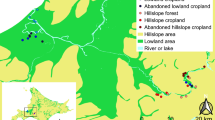Abstract
In this paper, the quantitative relationship between the wild fruit communities and direct environmental factors is discussed on the basis of detailed data on landscape scale habitats obtained through field vegetation investigation. The results from TWINSPAN and DCCA showed that: 1) In the distribution sections of the wild fruit forest in the Keguqin Mountain region, the basic patterns characteristic of the different habitats are due to topographic factors, nutrients and moisture conditions; 2) The elevation affected the most basic differentiation of plant communities in the study area, indicating that the elevation condition was the most important factor restricting the distribution of the wild fruit communities in the study area; 3) The close relationship between the moisture content in the upper soil layer and the elevation reflected the influence of moisture conditions on both wild fruit and herb-layer communities; 4) Nutrient differences not only indicated that the habitat conditions were different in themselves but also showed that the present nutrient conditions of the habitats were seriously affected by human activities. In summary, under complicated mountainous topographic conditions, the habitat conditions for the communities differed very significantly, and the combination of elevation, soil moisture content, total nitrogen, slope aspect, and pH value influenced and controlled the formation of community distribution patterns in the study area.
Similar content being viewed by others
References
Agricultural Chemistry Committee of Soil Science Society of China (1983) Conventional Methods for the Agricultural Chemical Analysis of Soil. Science China Press, Beijing. (In Chinese)
Bai L, Yan G.R, Xu Z (1998) Plant Diversity and Its Conservation in Wild Fruit Forests in Ili. Arid Zone Research 15(3): 10–13.
Chen LZ (1993) Present Situations of and Conservation Strategies for Biodiversity in China. Science China Press, Beijing.
CAS (2004) China Flora. Science China Press, Beijing.
Cui NR et al. (1983) Xinjiang Flora. Xinjiang Press of China.
Fang SB, Tang KY, Zhang XS, et al. (2009) Vegetation cover and its relationship with environmental factors at different scales in the Ordos Region of China. Acta Phytoecologica Sinica 33(1): 25–33.
Fang JY (2004) Exploring altitudinal patterns of plant diversity of China’s mountains. Biodiversity Science 12: 1–4.
Gaston KJ (2000) Global patterns in biodiversity. Nature 405: 220–226.
Hill MO, Šmilauer P (2005) TWINSPAN for Windows Version 2.3. Centre for Ecology and Hydrology and University of South Bohemia, Huntingdon and Ceske Budejovice.
Hou B, Xu Z (2005) Relationship of the occurrence and evolution of wild fruit forests in the Tianshan Mountains Region with climatic factors. Acta Botanica Boreali-Occidentalia Sinica, 25(11): 2266–2271.
Iverson LR, Dale ME, Scott CT, et al. (1997) A GIS derived integrated moisture index to predict forest composition and productivity of Ohio Forest (U.S.A.). Landscape Ecology 12: 331–348.
Jiang H, Huang JH, Chen ZL, et al. (1994) Sequencing and quantitative classification of the plant communities in the Dongling Mountain Region and their environmental interpretation. Bulletin of Botany 36: 539–551.
Körner C (1999) Alpine Plant Life: Functional Plant Ecology of High Mountain Ecosystems. Springer-Verlag, Berlin.
Lomolino MV (2001) Elevation gradients of species-density: historical and prospective views. Global Ecology and Biogeography 10: 3–13.
Liu XS, Lin PJ, Zhong JP (1993) Analysis of habitat for wild fruit forests in Ili and discussion on its occurrence. Arid Zone Research 3: 28–30.
Oommen MA, Shanker K (2005) Elevational species richness patterns emerge from multiple local mechanisms in Himalayan woody plants. Ecology 86: 3039–3047.
Pfeffer K, Pebesma EJ, Burrough PA (2003) Mapping alpine vegetation using vegetation observations and topographic attributes. Landscape Ecology 18: 759–776.
Tang ZY, Fang JY (2004) A review on the elevational patterns of plant species diversity. Biodiversity Science 12(1): 20–28.
Theurillat JP, Schlüssel A (2000) Phenology and distribution strategy of key plant species within the subalpine-alpine ecocline in the Valaisan Alps (Switzerland). Phytocoenologia 30: 439–456.
Ter Braak CJF (1997) Update Notes: CANOCO, Version 4.8. Agricultural Mathematics Group, Wageningen.
Whittaker RJ, Willis KJ, Field R (2001) Scale and species richness: towards a general, hierarchical theory of species diversity. Journal of Biogeography 28: 453–470.
Walter H (1979) Vegetation of the earth: the ecological systems of the geo-biosphere. Springer-Verlag, New York.
Wu Z (1991) The areal types of Chinese genera of seed plants. Acta Botanica Yunnanica 13: 1–139.
Wang WC et al. (1976) Higher Plants of China. Science China Press.
Zhang WH, Lu T, Ma KM, et al. (2004) Analysis on the environmental and spatial factors for plant community distribution in the arid valley in the upper reach of Minjiang River. Acta Ecologica Sinica 24: 552–559.
Zhang XS (1973) Study on eco-geographical characteristics of and coenology for wild fruit forests in Ili. Bulletin of Botany 15(2): 239–246.
Author information
Authors and Affiliations
Corresponding author
Rights and permissions
About this article
Cite this article
Zhuang, L., Tian, Z., Chen, Y. et al. Community characteristics of wild fruit forests along elevation gradients and the relationships between the wild fruit forests and environments in the Keguqin Mountain region of Iii. J. Mt. Sci. 9, 115–126 (2012). https://doi.org/10.1007/s11629-012-2009-2
Received:
Accepted:
Published:
Issue Date:
DOI: https://doi.org/10.1007/s11629-012-2009-2




